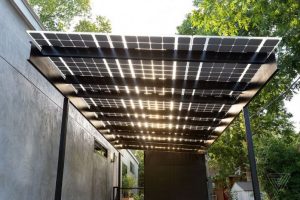
At this moment in the United States, there are around 2 million homes with solar panels. Taking into account that there are around 90 million single-family homes, that does not seem like much. But consider this: we are now on track to add a million new solar systems every year. It took a while to get here, but solar energy is increasingly becoming a popular choice to boost the Home of the Future.
The number of solar-powered homes “will improve pretty fast,” says Justin Baca, vice president of markets and research for the Solar Energy Industries Association. Panels are getting cheaper, growth is happening at double-digit rates every year, and some key politicians are getting excited: California recently approved the requirement that new homes include solar panels.
Of course, not all states are as lucky with the weather as California, but several solar companies say they are beginning to expand beyond Golden State and Florida. Anne Hoskins, policy director at Sunrun, the nation’s largest residential solar installation company, says the company is growing in states like Wisconsin and Illinois. David Bywater, CEO of Vivint Solar, says his company has many solar customers in New England. Baca points out that Maryland and the Carolinas are starting to have more solar panels, and New Hampshire and Vermont have a lot when you consider the size of the states.
Most houses with solar panels are still connected to the traditional electricity grid. Cloudy days (and eclipses) will occur, and that’s when it will be useful to be connected. Normally, when the system produces more energy than necessary, they export to the network. And when they produce less, they take from the network. The costs are based on consumption, says Baca. It is assumed that you should not export much more than you consume, so systems tend to be designed to be a little smaller than what is needed for 100 percent. (Usually, they will point to 80 to 90 percent of solar energy).
But that does not mean that being 100% out of the network is not possible, says Bywater. Energy storage is key when it comes to renewable energy at any scale; you want to have security There are some different ways to store energy, but the one that is most useful for the home is to use a lithium-ion battery, similar to your phone’s, but much, much larger. These can be connected to the solar panel system and store energy during sunny days. Then, they come into operation when the clouds appear.
Although solar energy is cheaper and increasingly popular, the industry faces some obstacles. Permits and inspection regimes are fragmented, explains Baca. Different jurisdictions and local governments have different versions of the building code, and all interpret them differently. “That generates a very fragmented and inconsistent process that makes companies have to worry about the installation of solar energy,” he says. For example, they could sell to a homeowner who is excited about the panels. But the process of obtaining permits takes three months, and then the client gets frustrated and cancels. So, although the California legislation was a victory for the solar industry, it could be the atypical place. Politics is still a bottleneck.
If solar power becomes ubiquitous, we’re likely to see it integrated with smart home energy management systems, predicts Bywater. These will regulate the household battery by using different sensors and solar panels. “The real trick is for the system to know how to make someone feel comfortable and how to be aggressive in conserving energy,” he says. You must know the optimal temperature of the home and how to change it according to the rates of the public services and the time of day to save money.
Ultimately, says Baca, “we are personally waiting for a day when solar energy is as ubiquitous as alternating current.” Very few places had air conditioners when the technology was available for the first time, and now it is rare to find a builder who creates a new house without that. “People think that something is missing when it is not there,” he says. “I think it’s where we go with solar energy, and I hope we’ll see it sooner rather than later.”
source by: ecoportal.net










Thanks a lot for the helpful information.